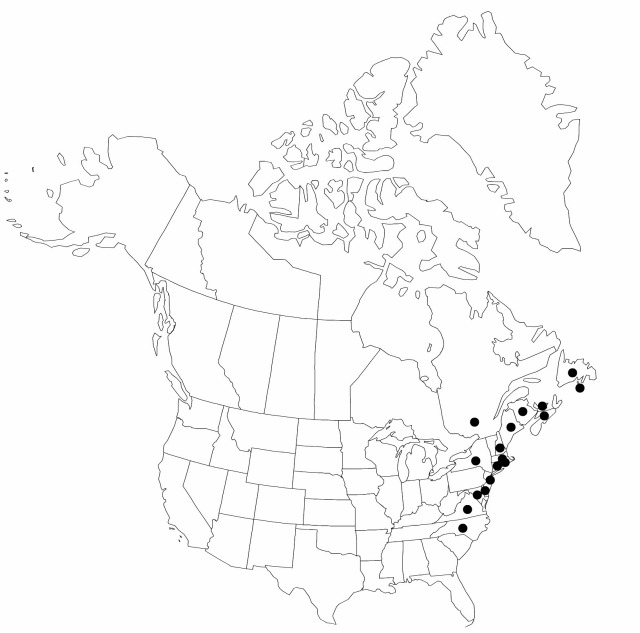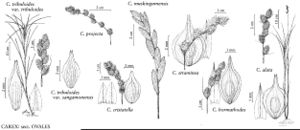Difference between revisions of "Carex hormathodes"
Rhodora 8: 165. 1906.
FNA>Volume Importer |
imported>Volume Importer |
||
| (3 intermediate revisions by 2 users not shown) | |||
| Line 8: | Line 8: | ||
}} | }} | ||
|common_names=Carex moniliforme | |common_names=Carex moniliforme | ||
| + | |special_status={{Treatment/ID/Special_status | ||
| + | |code=F | ||
| + | |label=Illustrated | ||
| + | }}{{Treatment/ID/Special_status | ||
| + | |code=E | ||
| + | |label=Endemic | ||
| + | }} | ||
|basionyms= | |basionyms= | ||
|synonyms={{Treatment/ID/Synonym | |synonyms={{Treatment/ID/Synonym | ||
|name=Carex straminea var. invisa | |name=Carex straminea var. invisa | ||
|authority=W. Boott | |authority=W. Boott | ||
| + | |rank=variety | ||
}} | }} | ||
|hierarchy=Cyperaceae;Carex;Carex sect. Ovales;Carex hormathodes | |hierarchy=Cyperaceae;Carex;Carex sect. Ovales;Carex hormathodes | ||
| Line 36: | Line 44: | ||
-->{{#Taxon: | -->{{#Taxon: | ||
name=Carex hormathodes | name=Carex hormathodes | ||
| − | |||
|authority=Fernald | |authority=Fernald | ||
|rank=species | |rank=species | ||
| Line 50: | Line 57: | ||
|publication title=Rhodora | |publication title=Rhodora | ||
|publication year=1906 | |publication year=1906 | ||
| − | |special status= | + | |special status=Illustrated;Endemic |
| − | |source xml=https:// | + | |source xml=https://bitbucket.org/aafc-mbb/fna-data-curation/src/2e0870ddd59836b60bcf96646a41e87ea5a5943a/coarse_grained_fna_xml/V23/V23_643.xml |
|genus=Carex | |genus=Carex | ||
|section=Carex sect. Ovales | |section=Carex sect. Ovales | ||
Latest revision as of 20:42, 5 November 2020
Plants densely cespitose. Culms 20–80 cm. Leaves: sheaths adaxially conspicuously green-veined nearly to collar, narrow hyaline band or sharp Y-shaped region at collar; summits U-shaped; distal ligules 2–4 mm; blades 3–5 per fertile culm, 14–25 cm × 1–3 mm. Inflorescences usually nodding, ± open, yellow-brown or reddish brown, 2.5–6 cm × 5–16 mm; proximal internode (2–)5–16 mm; 2d internode 5–17 mm; proximal bracts bristlelike. Spikes 3–9, distant, distinct, ellipsoid, 6–15 × 4–8 mm, base acute, apex obtuse; lateral spikes with staminate portion 2 mm or less at base. Pistillate scales reddish brown, often with green or pale midstripe, lanceolate, 3.5–4.9 mm, shorter and much narrower than perigynia, margin reddish brown, apex firm, acuminate or awned. Perigynia spreading, reddish brown, conspicuously 5-veined or more on each face, lance-ovate to weakly obovate, flat except over achene, 3.8–5.6 × 1.9–2.8 mm, 0.4–0.5 mm thick, base rounded, margin flat, including wing 0.4–0.7 mm wide; beak ascending, reddish brown at tip, flat, 1/2 length of body, ciliate-serrulate, abaxial suture with brown or reddish brown-hyaline margin, distance from beak tip to achene 2–3 mm. Achenes elliptic, 1.5–1.8 × 0.9–1.1 mm, 0.3–0.4 mm thick. 2n = 74.
Phenology: Fruiting mid summer.
Habitat: Maritime rock ledges, brackish or freshwater marshes, moist coastal sands
Elevation: 0 m
Distribution

St. Pierre and Miquelon, N.B., Nfld. and Labr. (Nfld.), N.S., P.E.I., Que., Conn., Del., Maine, Md., Mass., N.H., N.J., N.Y., N.C., R.I., Va.
Discussion
Some authors have treated Carex hormathodes as a variety of C. straminea. Characteristics of the perignyium beak and spike base, as well as the distinctive habitat and range clearly differentiate the taxa (P. E. Rothrock et al. 1997).
Selected References
None.
